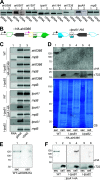The Two TpsB-Like Proteins in Anabaena sp. Strain PCC 7120 Are Involved in Secretion of Selected Substrates
- PMID: 33257527
- PMCID: PMC7847546
- DOI: 10.1128/JB.00568-20
The Two TpsB-Like Proteins in Anabaena sp. Strain PCC 7120 Are Involved in Secretion of Selected Substrates
Abstract
The outer membrane of Gram-negative bacteria acts as an initial diffusion barrier that shields the cell from the environment. It contains many membrane-embedded proteins required for functionality of this system. These proteins serve as solute and lipid transporters or as machines for membrane insertion or secretion of proteins. The genome of Anabaena sp. strain PCC 7120 codes for two outer membrane transporters termed TpsB1 and TpsB2. They belong to the family of the two-partner secretion system proteins which are characteristic of pathogenic bacteria. Because pathogenicity of Anabaena sp. strain PCC 7120 has not been reported, the function of these two cyanobacterial TpsB proteins was analyzed. TpsB1 is encoded by alr1659, while TpsB2 is encoded by all5116 The latter is part of a genomic region containing 11 genes encoding TpsA-like proteins. However, tpsB2 is transcribed independently of a tpsA gene cluster. Bioinformatics analysis revealed the presence of at least 22 genes in Anabaena sp. strain PCC 7120 putatively coding for substrates of the TpsB system, suggesting a rather global function of the two TpsB proteins. Insertion of a plasmid into each of the two genes resulted in altered outer membrane integrity and antibiotic resistance. In addition, the expression of genes coding for the Clp and Deg proteases is dysregulated in these mutants. Moreover, for two of the putative substrates, a dependence of the secretion on functional TpsB proteins could be confirmed. We confirm the existence of a two-partner secretion system in Anabaena sp. strain PCC 7120 and predict a large pool of putative substrates.IMPORTANCE Cyanobacteria are important organisms for the ecosystem, considering their contribution to carbon fixation and oxygen production, while at the same time some species produce compounds that are toxic to their environment. As a consequence, cyanobacterial overpopulation might negatively impact the diversity of natural communities. Thus, a detailed understanding of cyanobacterial interaction with the environment, including other organisms, is required to define their impact on ecosystems. While two-partner secretion systems in pathogenic bacteria are well known, we provide a first description of the cyanobacterial two-partner secretion system.
Keywords: TpsA; TpsB; antibiotic resistance; cyanobacteria; protein secretion; two-partner secretion.
Copyright © 2021 American Society for Microbiology.
Figures





References
-
- Mirus O, Hahn A, Schleiff E. 2010. Outer membrane proteins, p 175–230. In König H, Claus H, Varma A (ed), Prokaryotic cell wall compounds. Structure and biochemistry. Springer-Verlag, New York, NY.
-
- Hahn A, Schleiff E. 2014. The cell envelope, p 29–87. In Flores E, Herrero A (ed), The cell biology of cyanobacteria. Caister Academic Press, Norfolk, United Kingdom.
Publication types
MeSH terms
Substances
LinkOut - more resources
Full Text Sources
Other Literature Sources
Research Materials
Miscellaneous

